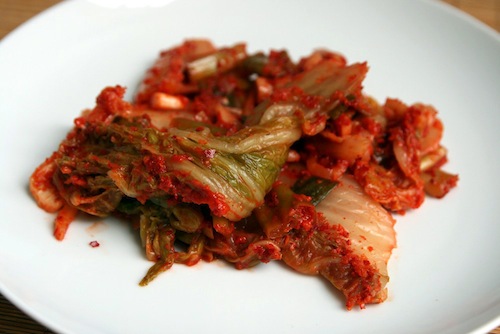
Kimchi

There was something else besides Sears catalog fashions that distinguished Taegu bargirls and set them apart from their more virtuous peers: namely their breath. These enterprising ladies, unlike their fellow countrymen young and old, one and all, did not eat kimchi. Their abstention was a dietary sacrifice of enormous proportions, yet entirely necessary if they wished to socialize with American servicemen, which is to say, if they wished to prosper financially.Kimchi has been called the national condiment or side dish of Korea, but it's considerably more than that. It's a defining characteristic, more gastronomically representative of Korea than salsa is of Mexico or garlic of Italy. Though less so today than in past periods when money and meat were scarce, kimchi has been a Korean way of 1ife.
Traditionally, kimchi was napa cabbage that, seasoned with hot chilies and garlic and soaked in brine, was buried in an earthenware crock for several months or until fermentation occurred. There are variations in which radishes, turnips , and/or cucumbers are added to the cabbage, but the fermentation is essential --- and the effect is the same: after one has eaten kimchi, one's breath could run a train. It could also run off any GI, marine, or airman --- no matter how romantically inclined, how fervently propelled forward by testosterone --- who happened to find his olfactory receptors enveloped in an alien halitosis so powerful it could pour a tank of herbicide on the reddest rose of passion.
Kissing a kimchi eater is one thing, eating kimchi is another, and while I was not altogether unlike my fellow servicemen in my aversion to the former, I came to join the ranks of the latter, introduced at my insistence to the indomitable dish by a darling girl who called herself "Sally" (odds are her real name was Kim), and whose warnings I ignored, creating some displeasure at the weather station since my entire supply of Listerine mouthwash was being funneled to Chairman Mao. [The author was smuggling items out of the PX to sell on the Korean black market; he found out later that many of these were being smuggled further on ... into China.]
I continue to eat kimchi today, albeit by necessity the made-in-America version. American kimchi? Indeed, it's possible to find refrigerated jars of the stuff in a fair number of U.S. supermarkets and specialty food stores, especially on the West Coast; and while it can add piquancy to tuna sandwiches or bowls of pork with steamed rice, it's pretty much a pale shadow of the authentic Korean product. The problem is that here the ingredients have rarely been fermented. It's possible today to ferment cabbage without burying it in the ground all winter (a Vietnamese woman in La Conner, Washington, made me some in her garage: moonshine kimchi), but in deference to Yankee sensibilities, most preserved cabbage in this country (in Japan, as well) is actually pickled rather than fermented. I call it "kimchi lite."
Kimchi lite is to authentic Korean kimchi what a lapdog is to a timber wolf what a billiards game is to a rugby match, what Disneyland is to Burning Man, what a golf cart is to a hot-rod Lincoln, what the Mormon Tabernacle Choir is to the Rolling Stones, what a sparkler is to a thunder cracker, what Curious George is to King Kong, what . . . well, you get the picture. Kimchi lite can enliven a tuna sandwich but hard-core Korean kimchi rocks the world.
--- From Tibetan Peach Pie
Tom Robbins
©2014 Ecco